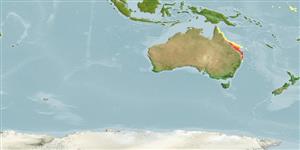>
Perciformes/Scorpaenoidei (Scorpionfishes) >
Aploactinidae (Velvetfishes)
Etymology: Matsubarichthys: Because of Matsubara, icthyologist in scorpenoid fishes. He was cited by Hilgendorf, 1880, and named after Shinnosuke Matsubara, director of Imperial Fisheries in Tokyo; inusitatus: Name means unusual or rare.
Eponymy: Dr Kiyomatsu Matsubara (1907–1968) was originally called Kiyomatsu Sakamoto but on marrying he took his wife’s name as the family surname. [...] (Ref. 128868), visit book page.
Environment: milieu / Zona climática / intervalo de profundidade / distribution range
Ecologia
marinhas demersal. Tropical
Western Pacific: known only from the holotype taken in Queensland, Australia.
Tamanho / Peso / Idade
Maturidade: Lm ? range ? - ? cm
Max length : 1.7 cm SL macho/indeterminado; (Ref. )
Espinhos dorsais (total) : 6; Raios dorsais (total) : 6; Espinhos anais: 2; Raios anais : 4; Vértebras: 21. Head extremely large, depressed. Body elongate, not compressed. Caudal fin damaged (rounded, without branched rays, 10 segmented rays and 4 unsegmented). Body scales absent, except for lateral line which are extremely long and tubular; first 3 touching each other. Its distinct, densely melanic spots on the head may be a transitory larval or juvenile character but cannot be verified until larger specimens are caught (Ref. 35981).
Known only from the holotype which may be at a transitory larvae and juvenile stage with a length of 0.85 cm SL (Ref. 35981). Maximum length value is preliminary and is assumed to be twice the length of the only juvenile specimen reported.
Ciclo de vida ou comportamento de acasalamento
Maturidade | Reprodução | Desova | Ovos | Fecundidade | Larvas
Poss, S.G. and G.D. Johnson, 1991. Matsubarichthys inusitatus, a new genus and species of velvetfish (Scorpaeniformes: Aploactinidae) from the Great Barrier Reef. Proc. Biol. Soc. Wash. 104(3):468-473. (Ref. 35981)
Status na Lista Vermelha da UICN (Ref. 130435: Version 2025-1)
Ameaça para os humanos
Harmless
Uso pelos humanos
Ferramentas
Relatórios especiais
Baixar XML
Fontes da internet
Estimates based on models
Preferred temperature (Ref.
123201): 24.3 - 26.7, mean 25.6 °C (based on 64 cells).
Índice de diversidade filogenética (Ref.
82804): PD
50 = 1.0000 [Uniqueness, from 0.5 = low to 2.0 = high].
Bayesian length-weight: a=0.01288 (0.00419 - 0.03963), b=3.03 (2.77 - 3.29), in cm total length, based on LWR estimates for this (Sub)family-body shape (Ref.
93245).
Nível Trófico (Ref.
69278): 3.0 ±0.3 se; based on size and trophs of closest relatives
Fishing Vulnerability (Ref.
59153): Low vulnerability (10 of 100).
🛈
